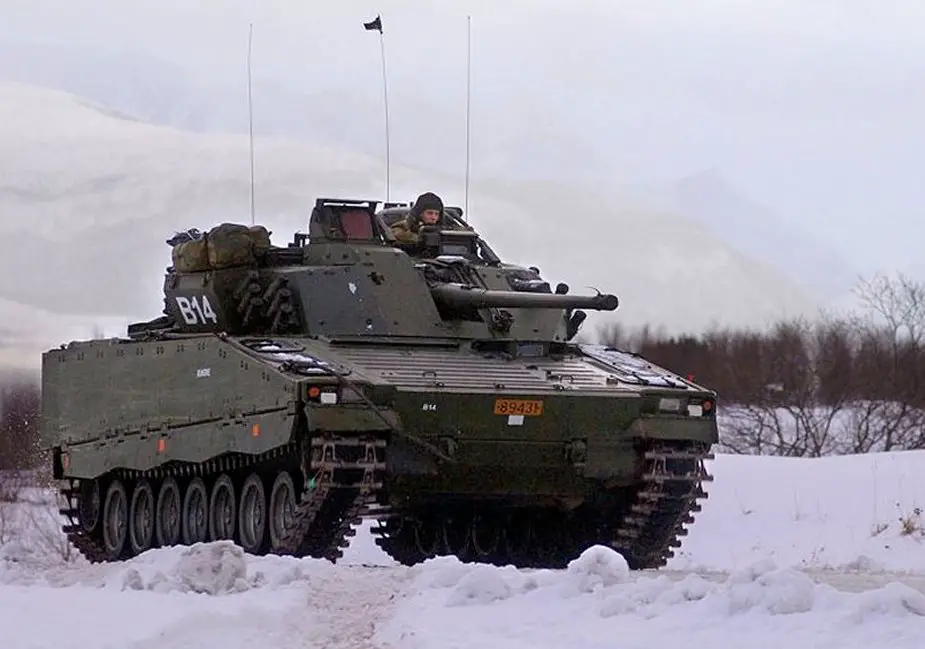The long term planning process outlines the continuous development of the Norwegian Defence Sector with respect to organization, infrastructure (garrisons and bases), personnel (numbers, composition, and qualifications) and materiel (existing equipment and new acquisitions). This process is carried out under the direction of the Royal Norwegian Ministry of Defence (MoD).

Norwegian CV9030N IFV (Picture source: Wikimedia/User Gjermis)
The Long Term Plan – Materiel forms the basis for all materiel procurements in the short term (4 years), the medium term (8 years) and the long-term perspectives (20 years).The plan is updated annually to reflect updates based on changing requirements, available resources, and progress in on-going acquisitions.
The Government recognizes the vital role the defense industry plays in support of the armed forces’ capabilities. This role ranges from the provision and maintenance of military equipment to the delivery of a wide range of support services. The Government’s national strategy for the defense industry was recently revised, and presented as a new White Paper to Parliament (Meld. St. 9 (2015–2016) Nasjonal forsvarsindustriell strategi) and covers the relationship between the Defence Sector and the defense industry.
The main reasons for presenting an updated White Paper are the developments in the security sphere over recent years, changes in the defense market both nationally and internationally, changes in terms and conditions, the introduction of the EU’s defense and security procurement directive, in addition to an increased focus on preparedness and security of supply.
The new White Paper focuses on national security interests and security of supply as the basis for the new policy and strategy. The policy will continue to maintain and develop an internationally competitive Norwegian defense industry in areas of relevance for the Norwegian Defence Sector. The strategy implies that Norway increasingly should cooperate with other nations on defense procurement. The strategy will also contribute to the necessary predictability for Norwegian export companies. The Government upholds the governmental support programme for marketing and industrial cooperation.
A central feature in the annual updating of the Long Term Plan – Materiel is the preparation and publication of an unclassified overview of long-term materiel requirements. This publication does not examine each planned project in detail but creates opportunities for in-depth discussions between the Defence Sector and industry. Hence, the industry can get an early insight into potential materiel investments. The materiel investment projects are subject to decisions and approval by the MoD and the Parliament.
Projects are typically conceived in two ways. One is the top-down approach which to a large extent deals with the major weapon systems resulting from strategic planning processes. The second way is the bottom-up approach which to a large extent deals with smaller requirements typically initiated by the services and users. At an early stage, the proposal is known as Project Idea (PI), which is assessed by the relevant investment programme. If the investment programme finds the PI to have merit, it is subsequently recommended to the MoD for approval and eventually further pursued and developed into a tentative project. This is the first formal decision point.
The Investment Plan for the Defence Sector is focusing on ongoing projects in order to improve availability and endurance. The purpose is to make sure that the capabilities we already have are operational. Thereafter, investments in vital and strategic capabilities in order to maintain and increase situational awareness and control are prioritized. The procurement of new F-35 fighter aircraft, submarines and Maritime Patrol Aircraft (MPA) have priority. Reductions in some selected areas give possibilities to invest in new, modern and vital systems.
The Investment Plan also covers significant investments in intelligence, surveillance, survivability, and combat power to strengthen Norway’s and NATO’s ability to prevent and deter the use of force, and maintain situational awareness in the North Atlantic and the High North.
The bulk of the investments within the Land Systems Programme are:
• Combat vehicles (medium-weight, standard armored vehicles CV90, armored reconnaissance systems (CV90)) and a new 155 mm artillery system.
• New Main Battle Tank (MBT) and new Combat Service vehicles on Leopard 2 chassis (Recovery, Bridge layers, and Engineer vehicles).
• Upgrade of M-113 and SISU armored vehicles. A number of smaller investments in military logistics within five main subject areas: * CBRN-protection (Chemical / Biological / Radiological / Nuclear). * Engineering. * Logistics. * Medical Service. * Military Geography (maps and geographical information).
• Acquisitions of equipment for the dismounted soldier. This includes personal equipment in protection, clothing, mobility, and endurance. Furthermore, the soldier’s C2I-systems need modernization. Projects for a continuing modernization of the soldier equipment are planned within the core functions lethality, protection, mobility, sustainability, C2I and logistics.
• Acquisitions for the Special Forces, due to sensitivity reasons they are not described in full range in this document.
The Information Infrastructure Programme is by nature a complex programme consisting of different kind of ICT-services, -solutions and –systems. The Information Infrastructure Programme emphasizes the investment profile on tactical platform, data center solutions and to increase the ability of information sharing and interoperability. In detail, the programme consists of:
• Modernization of quantum resistant encryption solutions.
• Providing ICT-infrastructure for new defense base structure.
• Augmentation and modernization of mobile and static communication infrastructure.
• Modernization of C4ISR and JISRSystems for Information Security and Computer Network Defence.














